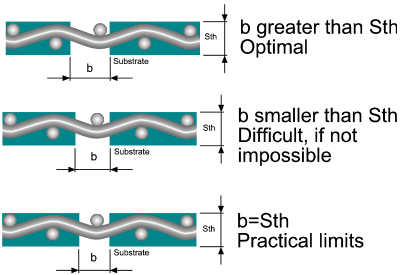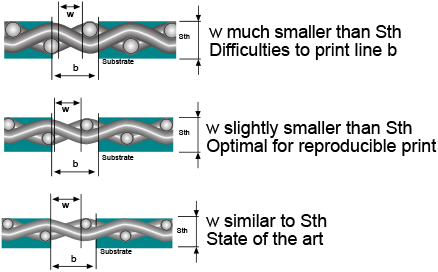What should my stencil characteristics be when printing fine lines?
When printing fine lines, it is important to match the requirements of the image to the mesh/wire cloth used. There are many elements of the mesh/wire that limit reproducibility of fine lines. Through lab testing, several parameters for fine line printing have been defined.
I. Stencil Thickness:
Screen thickness includes the mesh thickness and emulsion thickness. The total stencil system (mesh/wire cloth + emulsion) thickness should be smaller or equal to the finest line being printed. If the stencil system thickness is equal to or larger than the width of the line, ink transfer difficulties may occur. The proper stencil thickness is not a solve-all for printing fine lines. There are other parameters that a printer must take into consideration, such as the line’s angle to the mesh, and the thread diameter of the mesh.

II. Mesh Opening:
The same logic that is applied to the stencil system thickness and line width ratio may also be applicable to the mesh opening. Mesh openings that are similar or slightly smaller than the stencil thickness are optimal for print reproduction. Mesh openings that are much smaller than the stencil thickness may interfere with ink transfer – but may be required for durability. Thus, high mesh count is not always essential. A low mesh count with the thinnest thread diameter provides the best results for fine line reproduction. The sum of one mesh opening dimension and one nominal thread diameter dimension should be at least 1.5 times the width of the printed line. Wire cloth typically provides the best printing characteristics, optimal ink transfer and minimal thread interference, when printing some of the finest lines.

Fine graphic elements or lines finer than 100 microns (3.9 mils) require a high level of expertise and may be difficult to reproduce consistently. Practical reproducible widths begin at 150 microns (5.9 mils) with line widths of around 200 microns (7.9 mils) being relatively easier to reproduce. Angling the mesh to the frame may assist with reducing the amount of thread interference with the printable lines so that finer detail may be achieved. In general, the sum of the mesh opening (Mo) to the thread diameter (Td) and multiplying by the square root of two (1.414), the finest printable line (B) at a 45° angle is determined.
B = (Mo + Td) x 1.414
|
|
|
|
|
|
|
|
|
|
|
|
|